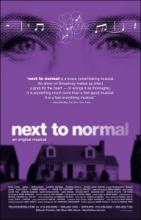That show, Next to Normal, didn’t disappoint as entertainment. It had an enjoyable and involving rock score, a talented cast of six actors, and inventive staging and lighting. It also had a plot that dealt seriously, often movingly, about something that’s not a natural for a musical’s premise: mental illness. The show’s book received enough attention after the opening in April 2009 that earlier this year it won the Pulitzer Prize for drama, following a Tony the score received as 2009′s best.
Despite that, it seemed to me that the show’s book and lyric author, Brian Yorkey, flubbed the challenge of building a satisfying dramatic arc on this subject while setting it to music and coming in under 2 hours. Whether or not that’s the explanation, the show’s story of a middle-aged mother and wife haunted by a powerful, delusional fantasy of the son she lost when he was 8 months old, slips up with its simplistically negative and clichéd portrayal of cand psychotherapy. At the end of Next to Normal, the central character, Diana, prevails by facing down her mental demons drug- and treatment-free, finally talking with her daughter and husband about their troubled past. Familial love and open communication allow Diana to overcome her delusions and manic depression. The bad guys in this feel-good ending are Diana’s two psychiatrists and their ineffectual treatments.
What’s remarkable is that Mr. Yorkey denies making the psychiatrists the villains. Quoted in an article by Patricia Cohen in The New York Times soon after Next to Normal opened last year, Mr. Yorkey says: “Some people have walked away thinking we were against psychologists or psychotropic drugs and nothing could be further from the truth.” That assertion makes me wonder which theater he’s been visiting and whether it was the same one I sat in the other evening.
The musical I saw sets the tone with an early, first act song in which Diana reviews her pharmacologic history in the song ”My Psychopharmacologist and I,” which catalogs the “Zoloft and Paxil and Buspar and Xanex, Depacon, Chronaphin, Ambien, Prozac, Ativan calms me when I see the bills. These are a few of my favorite pills.” Diana later croons about the adverse effects she develops, and that her regimen has left her mentally numb. “I don’t feel anything,” she says, to which her psychiatrist sagely replies: “Patient stable.” Soon after, Diana decides to go drug free, happily disposing of her “Risperdal, Valium, and Xanax.”
When she then has an unsuccessful suicide attempt, a new psychiatrist (described in the show as a “rock star”–an infallible expert) recommends electroconvulsive therapy, a treatment depicted as menacing and extreme and, once again, ultimately ineffectual. All the ECT achieves for Diana is substantial memory loss, and then a return of her powerful and incapacitating delusions. As the second act winds down, she abandons most psychiatric treatments, accepting only talk therapy, and at the show’s end Diana achieves transcendence fueled by her family’s love and new-found openness.
Of course these can be powerfully therapeutic, but the show casts it as a simple black and white situation, with a facile Forty-second street philosophy working while mainstream psychiatry completely failed.
—Mitchel Zoler (on Twitter @mitchelzoler)


